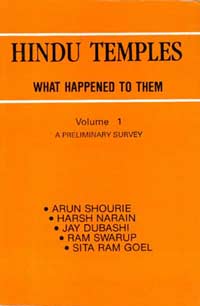|
Page1

Chapter Four
In The Name Of Religion
- by Sita Ram Goel
We shall now take up the explanation provided by the theology of Islam derived from the Quran and the Hadis.
Ibn Ishaq, the first biographer of the Prophet, devotes many pages to a description of Arab polytheism at the time when Islam started taking shape. Every Arab household, he tells us, had an idol of some God or Goddess. He also gives the names of many idols which were housed in sanctuaries maintained by different tribes across the Arab peninsula. The Ka‘ba at Mecca which housed 360 idols was only one of these sanctuaries, though it was the most prestigious. One of the idols in the Ka’ba was named Allah. Though it had some primacy over other idols, it was far from being an exclusive deity. Besides, there were many sacred groves and places of pilgrimage visited by Arabs on special occasions.
At the same time, Ibn Ishaq informs us that Monotheism was becoming an attractive creed among some sections of the Arab elite. It was the creed of the Roman, Iranian and Abyssinian empires which inspired awe and admiration among the Arabs at that time. Many Jews and Christians were present, individually or in communities, in the more important Arab towns. These People of the Book took great pride in their worship of the one and only God and looked down upon the Arabs who had had no Prophet, who possessed no Book and who worshipped stones and stocks. They aroused a sense of inferiority in the minds of those Arabs who came in close contact with them but who were not equipped with an alternate theology that could defend their own Gods and Goddesses. Such Arabs looked forward to the day when Arabia also would have a Prophet and a Book of its own.
Author - Shri Sita Ram Goel
|